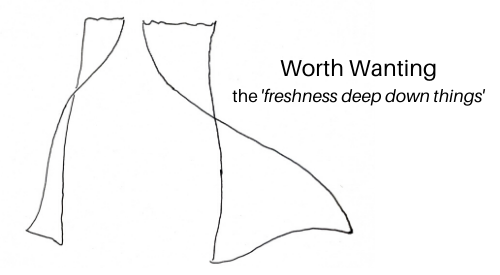
Iconoclasm. A fear-inspiring counter-culture word. Who can forget the destructions of the iconoclastic civil wars of Constantinople or the Reformation? But freshness is the spirit of iconoclasm. Let me explain.
The word icon is, of course, in common use. The home screens of our phones are full of icons, and symbols, and tokens, each of which stands for something else. ‘Stands for’, meaning this is as much as you need to know, right now, to manage or work with whatever is being represented or pointed to.
Much of our lives, that part I’ve referred to as our suitorium, operates in iconic mode. We often don’t see things as they are but simply that they are where they are. Habits of unthinking expectation fill in the rest. This is a great convenience, maximizing effectiveness and optimizing efficiency and facilitating classification through a set of automatic presumptions and assumptions. There’s a certain coziness about suitorium space, like a room decorated with portraits and landscapes that, now one, now another, catch our eye when we look up: that’s my partner, that’s me, that’s where I work, and so on. My suitorium is the managed working set of icons which stand for elements in my life I treat as compliant and/or contained.
Contrast this with my alitorium, the non-iconic (read: literal, actual, just as real as I am) others and othernesses in me and around me, each with claim on existence equal to my own, and able to (and often very ready to) resist and insist. My alitorium is full of others and othernesses redolent of beyondness, of interestingness, of unsuspected/unexpectedness, of freshness itself.
(This is a different but better presentation of the concepts of alitorium/suitorium than in the posts Outside, Inside and Pep talk and Confrontations.)
Livingness is the willingness to be iconoclastic, to take our everyday icons and crack them open like eggs to find the meat inside. That is, to regularly sneak behind the white board full circles and arrows and getting things done, and gaze on others or othernesses as themselves, without our masks on their faces. These moments are generative occasions, or encounters.
Livingness is the dynamic interface between our suitoria and our alitorium, our iconic world regarding ourselves and not-ourselves, and the non-iconic world of outer and inner others.
Livingness is an aspect of our disposition, our prevailing outlook, mood, tendency of spirit, that we can encourage in ourselves, others, and the world by encountering. Because, to make common cause with another’s livingness is to provide adopt the stance that provides the space that fosters iconoclasm, and welcomes freshness.
Play, especially ironic play, makes sport with icons, sometimes pulling icon out of icon like a magician emptying a hat of rabbits, but sometimes play just recognizes icons as such which is the first step to cracking them open to see and taste what’s inside.
I don’t suggest knocking the noses off statues or stabbing pictures, but we need a healthy balance of icon-izing and iconoclasm in our lives. Encountering provides this.
